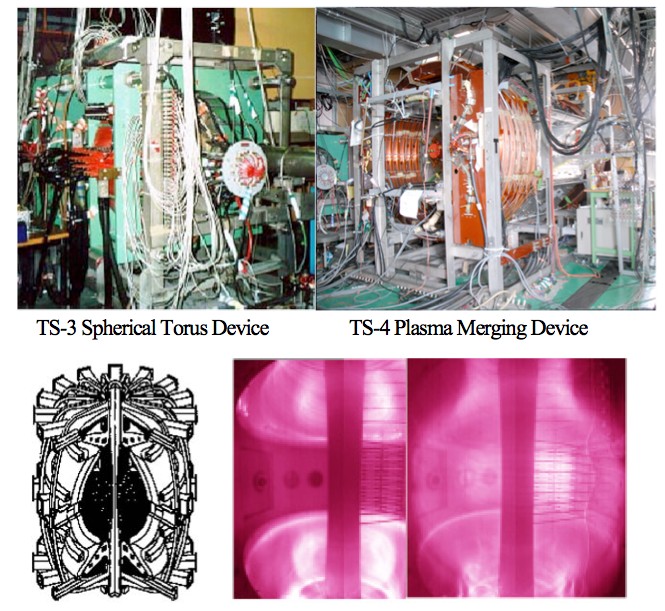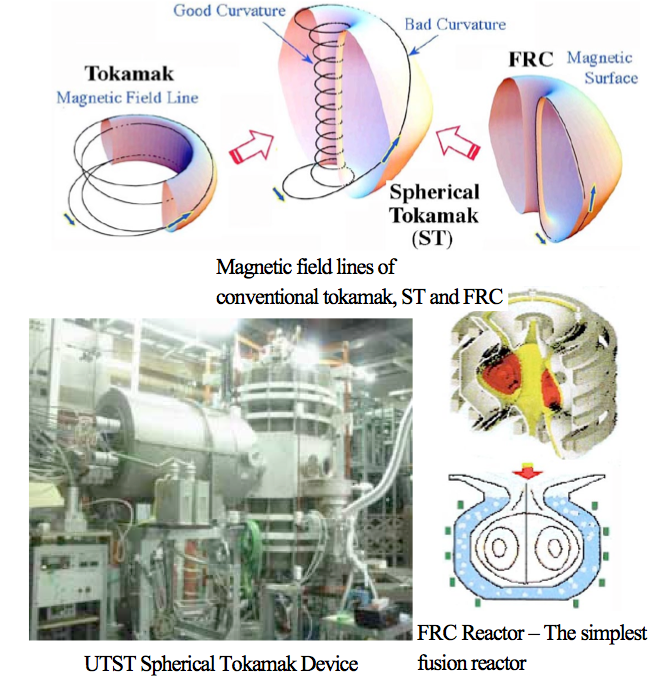Ono & Inomoto & Tanabe Laboratory
The main research fields of Ono & Inomoto & Tanabe Laboratory are Plasma Physics and Engineering, especially development of nuclear fusion reactor, alternative energy sources, space and solar plasmas, plasma applications.
Our main motivation is the energy and environmental crisis that we will encounter around 2050. They are caused by (1) environmental devastation by C02, NOx and SOx from fossil fuels, (2) depletion of energy sources:, especially oil and gasses, (3) expanding energy consumption. We have to replace the present fossil fuels – causes for CO2, NOx, SOx by nuclear fusion reactors which provide us exhaustless energy without any global warming gas.. The present fusion research already realized fusion power output larger than the input power. The unsolved issue is to realize economic and compact fusion reactor as early as possible. Its key question is whether we can develop ultra-high-beta confinement whose efficiency overcomes the present mainstream: called tokamak. The beta value is the plasma thermal pressure confined by the unit magnetic field. P/(B2/2µ0)
We have been developing a number of new ideas related with spherical torus confinements: Spherical Tokamak (ST) and Field-Reversed Configuration (FRC) using the TS-3 and TS-4 devices. Recent fusion research put more emphasis on economical efficiency and simplicity of confinements, leading us to the construction of world largest spherical torus device NSTX at Princeton University and MAST at Culham Laboratory .

■Ultra-High Beta ST Experiment
Recently, the spherical tokamak (ST) has received increased attention as a promising candidate for economical and highly-efficient fusion reactor. The Spherical Tokamak Rector Merging Spherical Tokamak Discharge (UTST)
Recently, the spherical tokamak (ST) has received increased attention as a promising candidate for economical and highly-efficient fusion reactor. The STs have a unique “apple”-like shape with a sphere boundary as shown in the figure above. Its aspect ratio is decreased down to 1-2 from 3-4 of the conventional tokamaks for increasing the plasma beta. An important question is what is the upper limit of the plasma beta for STs. In 1999, we produced the ultra-high beta (>50%) ST in TS-3 using our new method: high-power heating of magnetic reconnection. Its highest beta was as large as 60%, the world-record vale. Its high thermal pressure was maintained efficiently by small magnetic field, simply because it is located for the first time in the second-stable state against ballooning instability which is the most dangerous mode for high-beta plasmas. Due to the successful results, new upgraded project:: UTST spherical tokamak was accepted by Japanese government at 2006 and will start initial operation this year.
■Optimization of Spherical Torus Plasmas
Our goal is to optimize the compact fusion confinement using promising ideas of STs and FRCs. The FRC has the simplest magnetic field structure solely composed of the poloidal magnetic field, while the ST has both poloidal and toroidal magnetic fields., as shown in the figure above A major issue for the STs is to increase the plasma beta, maintaining the long confinement time of conventional tokamaks. The FRCs are already equipped with a promising beta~100% due to its simplest field structure but are needed to improve its poor confinement time and inefficient formation method. We developed a new economical formation method of FRCs using axial merging of two spheromaks. The merging process was found transform the low-beta spheromaks into high-beta FRC by means of energy conversion effect of reconnection. Its energy efficiency is a few times higher than the conventional theta-pinch formation, realizing the new-stage experiment of FRC formation and sustainment. We believe that the mixture of STs and FRCs will be a key to optimize the spherical torus confinement with high-beta and long confinement. These successful results lead us to the upgraded experiment TS-4 merging experiment that start operation at 2000.
■Key Experiments/ Simulations for Solving Magnetic Confinement Properties
We have developed new experiments to solve keys for the magnetic confinement. Questions are for example why the instability and reconnection of magnetic field lines takes place for those magnetic configurations. We developed a new laboratory experiment of magnetic reconnection by torus plasma merging. Its magnetic Raynolds number, temperature and density are much higher than the conventional method, so that it was adopted by world-wide reconnection experiments: MRX (Princeton U..), VTF(MIT), Swift-FRC(NASA), SSX(Swarthmore C.) etc. We are now promoting international collaboration on reconnection research.
■ Web:http://tanuki.t.u-tokyo.ac.jp/


